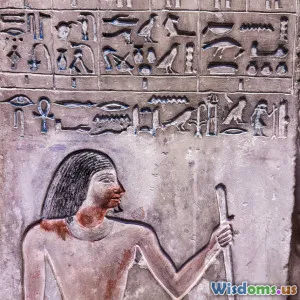
Decoding the Languages of the Ancients
6 min read Explore the fascinating world of ancient languages and their mysteries, uncovering the secrets of lost civilizations. (0 Reviews)
Decoding the Languages of the Ancients
Understanding the languages of ancient civilizations is like piecing together a puzzle that reveals the thoughts, culture, and history of humanity itself. These languages, often inscribed on stone tablets, papyrus, or ancient monuments, serve as the keys to unlocking the mysteries of our past. This article delves into various ancient languages, the challenges of deciphering them, and their significance in understanding ancient cultures.
The Importance of Ancient Languages
Languages are not merely tools for communication; they are the very fabric of culture and identity. Ancient languages provide insights into the social, political, and economic structures of the civilizations that spoke them. For instance, the language used in ancient Egypt, known as Egyptian, not only helps us understand religious practices but also offers a glimpse into daily life and governance.
The Role of Language in Civilization
- Cultural Identity: Languages often encapsulate the worldviews of their speakers. The Sumerians, for example, used cuneiform to document their myths and literature, which gives us insight into their beliefs and values.
- Historical Record: Languages preserve history in ways that other forms of documentation cannot. The Rosetta Stone, inscribed with the same text in three scripts, was pivotal in understanding Egyptian hieroglyphs.
- Social Structure: The way language is used can reveal the social hierarchy within a civilization. The use of specific dialects or scripts often reflected social status or education.
Notable Ancient Languages and Their Mysteries
1. Cuneiform
Developed by the Sumerians around 3200 BC, cuneiform is one of the earliest writing systems. It was initially used for record-keeping but evolved into a complex script for documenting literature, laws, and administrative texts.
Key Points:
- Deciphering: The breakthrough in understanding cuneiform came in the 19th century when scholars like Henry Rawlinson began to decode it using the Behistun Inscription.
- Cultural Insights: Cuneiform texts reveal a wealth of information about Sumerian society, including their economy, religion, and even personal letters between people.
2. Hieroglyphs
Hieroglyphs were used in ancient Egypt for over three thousand years. They combine logographic and alphabetic elements, making them both beautiful and complex.
Key Points:
- Deciphering: The Rosetta Stone was crucial for understanding hieroglyphs as it provided a translation in Greek, which was already known.
- Artistic and Religious Significance: Hieroglyphs were often used in religious texts and inscriptions in temples, reflecting the Egyptians' beliefs about the afterlife and the divine.
3. Linear B
Linear B is a syllabic script used by the Mycenaean Greeks. It is one of the earliest forms of Greek writing, dating back to the 15th century BC.
Key Points:
- Deciphering: The script was deciphered by Michael Ventris in the 1950s, revealing administrative records and insights into Mycenaean society.
- Cultural Insights: The texts show that the Mycenaeans had a centralized economy and complex social structure.
Challenges in Decoding Ancient Languages
Deciphering ancient languages is fraught with challenges. Many texts have been lost, and those that survive are often incomplete or damaged. Moreover, the context in which these languages were used is crucial. A word or phrase may have multiple meanings depending on its cultural and historical context.
1. Limited Resources
Often, only a handful of inscriptions or texts remain, which makes it difficult to develop a comprehensive understanding of the language. For example, the Etruscan language, despite being known from thousands of inscriptions, remains largely undeciphered due to the lack of bilingual texts.
2. Cultural Context
Understanding the cultural context is essential for accurate interpretation. For instance, a term used in a religious text may not carry the same meaning in a legal document. Scholars must be adept in both linguistics and anthropology to make accurate interpretations.
The Future of Ancient Language Studies
As technology advances, so does our ability to study ancient languages. Digital tools and artificial intelligence are beginning to play a role in deciphering scripts and analyzing texts. Techniques like machine learning are being applied to recognize patterns and make educated guesses about unknown languages.
Conclusion
Decoding the languages of the ancients is not just an academic pursuit; it is a journey into the heart of human civilization. By understanding these languages, we gain insights into the thoughts, beliefs, and daily lives of our ancestors. As we continue to uncover and decipher ancient texts, we open doors to knowledge that has been hidden for centuries, allowing us to better understand our shared human history.
Rate the Post
User Reviews
Popular Posts





















